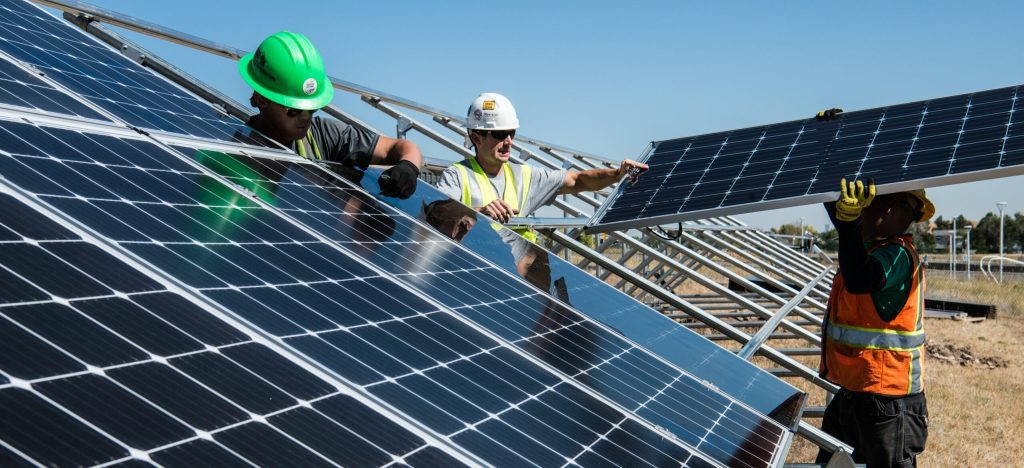Last week, Congress approved a $2 trillion emergency relief bill to ease some of the effects of COVID-19 on the American economy. But this is just the start of recovering the economy after the pandemic; economists project that we might be heading into a major depression, and one estimate of future unemployment rates tops 30 percent.
Meanwhile, the climate crisis hasn’t gone anywhere. Emissions may have gone down a bit as factories closed and people stayed at home, but that means little if we simply return to the status quo. In fact, we could even see progress on climate scaled back. Last week, the EPA announced it was easing penalties for polluters affected by the COVID-19 response; while the order is described as temporary, some are worried about it amounting to an open-ended relaxation of environmental protections. At the same time, oil prices are low, which could lead consumers to buy gas guzzlers when they return to work. “Without measures by governments, cheaper energy always leads consumers to use it less efficiently,” writes Fatih Birol, executive director of the International Energy Agency, in a March 14 post for the IEA. “It reduces the appeal of buying more efficient cars or retrofitting homes and offices to save energy.”
That’s why Birol and others think that, moving forward, we need a climate-focused stimulus. Government investment into clean energy not only hastens transitioning away from fossil fuels, Birol argues in the IEA article, it generates jobs.
Now, a team of policy experts from universities and think tanks has moved that argument further, by drafting what might be the most detailed “green stimulus” proposal to date. In a Medium post published on March 22, the authors outline their plan. In addition to addressing the immediate impacts of the COVID-19 pandemic, “we must also begin planning our economic recovery in a way that protects us from the impact of climate change and lifts up workers and frontline communities,” they write. “Thus, we propose an ambitious Green Stimulus of at least $2 trillion that creates millions of family-sustaining green jobs, lifts standards of living, accelerates a just transition off fossil fuels, ensures a controlling stake for the public in all private sector bailout plans, and helps make our society and economy stronger and more resilient in the face of pandemic, recession, and climate emergency in the years ahead.”
After the initial influx of $2 trillion is used up, the stimulus would be renewed every year, at an amount equivalent to 4 percent of the country’s GDP (about $850 billion). This flow of cash would continue until the economy reaches net zero carbon emissions and unemployment is below 3.5 percent.
The proposal includes a host of policies designed to address eight different categories: housing, transportation, labor and manufacturing, energy, agriculture, infrastructure, public lands, public investment and innovation, and green foreign policy. The authors have all advised presidential campaigns, including Democratic candidates who made bids for the 2020 election. So, the proposal reflects a collection of their climate policies, packaged together so that members of Congress can use it to base future stimulus proposals on.
J. Mijin Cha, a coauthor of the proposal and environmental policy scientist at Occidental College, says that though a relief bill just passed, another stimulus will certainly be proposed soon. “It’s up to us to make sure that [the new stimulus] centers on workers, communities, and the climate,” says Cha, explaining that the policies on their proposal the lay the framework for a transition that would helps worker in fossil-fuel centered industries find good jobs in the shift to a carbon-free economy.
Among its numerous policies, the proposal has a big focus on public-facing, visible projects. One of the priorities is that of addressing the maintenance backlogs of the National Parks Service and U.S. Forest Service, says Ayana Elizabeth Johnson, another coauthor on the proposal and marine biologist who advised Elizabeth Warren’s climate plans. Another example is a “Fix It First” mandate for infrastructure, requiring that new transportation funds be used for repairing existing bridges, roads, and other facilities. Importantly, this includes retrofitting existing roads with measures like dedicated bike and bus lanes. Cha says that this mandate creates jobs and advances climate and energy goals at the same time. “These programs create jobs immediately and very publicly,” she says. “So you will know how you benefited from the investment of these stimulus ideas.”
This is in contrast to the 2009 American Recovery and Reinvestment Act stimulus, says coauthor Billy Fleming, who directs the Ian L. McHarg Center at the University of Pennsylvania and is a senior fellow at Data for Progress. That bill, he says, was not only too small but also ended up funding a number of projects that weren’t visible and had little public enthusiasm behind them.
Johnson adds that the proposal also includes provisions for ramping up clean energy research funding. While there are a number of ways to address the climate crisis right now, that doesn’t mean we should not continue to improve technology, she says. That’s why one policy in the proposal suggests boosting funds to ARPA E, the U.S. government agency performing energy research, by up to 100 times. “In order to address the climate crisis, we do still need to be thinking about better ways to do things, thinking about offshore wind, offshore solar, and biofuels and all of these things,” says Johnson. “There’s still a lot of room for innovation.”
Now, the team is working on getting the word out and talking with interested legislators. They’ve heard from several offices in Congress, and are having near-daily conversations on the proposed policies, says Fleming. “We’re doing all the things we can to make sure the case is as strong as possible for these ideas.”









